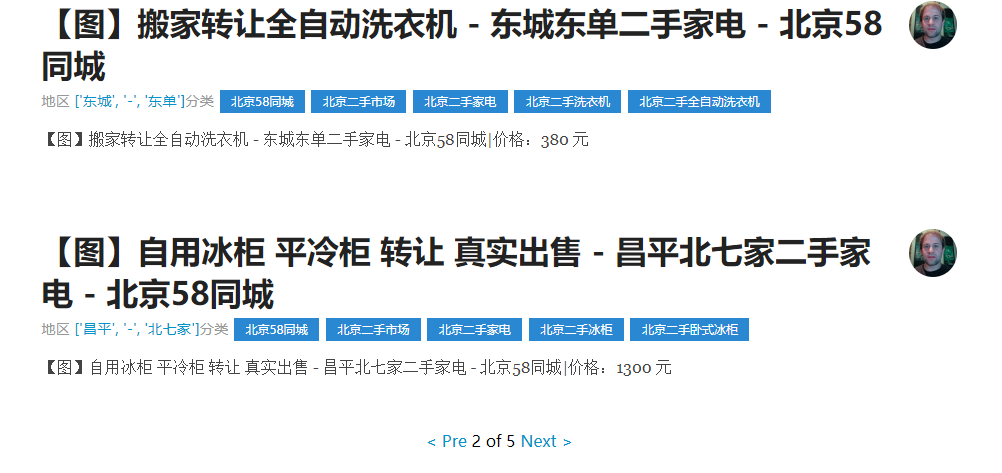这篇文章主要讲解了使用Django搭建网站实现商品分页功能的方法,内容清晰明了,对此有兴趣的小伙伴可以学习一下,相信大家阅读完之后会有帮助。
装好Django,写好index.html后,可以展示网页了。但是这只是静态页面,没有关联数据库,也不能分页展示商品信息。本节连接mongodb数据库(事先已准备好数据),从中取出几十条商品信息,每页展示4个商品信息,并具有翻页功能,做好的页面效果大致如下:

开始代码:
1、在settings.py(项目名称目录下)中,增加2段代码,分别是static文件夹位置和连接mongodb的代码:
STATIC_URL = '/static/'
STATICFILES_DIRS = (os.path.join(BASE_DIR,'static'),) # 指定static文件夹位置
from mongoengine import connect
connect('ganji', host='127.0.0.1', port=27017) # 连接ganji数据库2、在models.py(本APP目录下)中,代码:
from django.db import models
from mongoengine import *
# Create your models here.
# 创建帖子信息类,继承自mongoengine的文件类<br data-filtered="filtered">class PostInfo(Document):
area = ListField(StringField())
title = StringField()
cates = ListField(StringField())
price = StringField()
pub_date = StringField() # 数据集里面所有的字段都要有,就算不用也得列出来
url = StringField()
look = StringField()
time = IntField()
cates2 = StringField()
meta = {'collection':'goods_info'} # 定位好是goods_info数据集3、在views.py(本APP目录下)中,代码:
from django.shortcuts import render
from sample_blog.models import PostInfo # 导入已写好的数据结构
from django.core.paginator import Paginator # 导入分页器
# Create your views here.
def index(request):
limit = 4 # 每页放几条帖子
all_post_info = PostInfo.objects[:20] # 取前20个帖子的数据
paginatior = Paginator(all_post_info, limit) # 用分页器分页
page_num = request.GET.get('page', 1) # 取request中的页码,取不到就为1
loaded = paginatior.page(page_num) # 取page_num那一页的数据,一般是4条
context = {
# 首条固定的帖子信息
'title': '三星 A5 白色',
'des': '【图】三星 A5 白色 没有打开过 - 朝阳望京台式机/配件 - 北京58同城',
'price': '1500',
'area': ["朝阳", "望京"],
'tag1': "北京二手市场",
'tag2': "北京二手台式机/配件",
# 每页更新的帖子信息
'one_page_post': loaded
}
return render(request, 'index.html',context)4、修改index.html文件,主要修改了有文字标注的部分:
<div class="posts">
<h2 class="content-subhead">Pinned Post</h2>
<!-- A single blog post -->
<section class="post">
<header class="post-header">
<img class="post-avatar" alt="Tilo Mitra's avatar" height="48" width="48" src="{% static 'img/common/tilo-avatar.png' %}">
<!-- 修改了{{title}}等 -->
<h3 class="post-title">{{ title }}</h3>
<p class="post-meta">
地区 <a href="#" rel="external nofollow" rel="external nofollow" rel="external nofollow" rel="external nofollow" rel="external nofollow" class="post-author">{{ area }}</a> under <a class="post-category post-category-design" href="#" rel="external nofollow" rel="external nofollow" rel="external nofollow" rel="external nofollow" rel="external nofollow" >{{ tag1 }}</a> <a class="post-category post-category-pure" href="#" rel="external nofollow" rel="external nofollow" rel="external nofollow" rel="external nofollow" rel="external nofollow" >{{tag2}}</a>
</p>
</header>
<div class="post-description">
<p>
{{ des }}|价格:{{ price }}
</p>
</div>
</section>
</div>
<div class="posts">
<h2 class="content-subhead">Recent Posts</h2><!-- 增加for循环,将one_page_post值带入 -->
{% for item in one_page_post %}
<section class="post">
<header class="post-header">
<img class="post-avatar" alt="Eric Ferraiuolo's avatar" height="48" width="48" src="{% static 'img/common/ericf-avatar.png' %}">
<h3 class="post-title">{{ item.title }}</h3>
<p class="post-meta">
地区 <a class="post-author" href="#" rel="external nofollow" rel="external nofollow" rel="external nofollow" rel="external nofollow" rel="external nofollow" >{{ item.area }}</a>分类<!-- 再增加一个for循环,把cates里的元素都展示出来 -->
{% for cate in item.cates %}
<a class="post-category post-category-pure" href="#" rel="external nofollow" rel="external nofollow" rel="external nofollow" rel="external nofollow" rel="external nofollow" >{{ cate }}</a>
{% endfor %}
</p>
</header>
<div class="post-description">
<p>
{{ item.title }}|价格:{{ item.price }}
</p>
</div>
</section>
{% endfor %}
</div>
<!-- 增加本段div,实现页面底部可翻页 -->
<div align="center">
{% if one_page_post.has_previous %}
<a href="?page={{ one_page_post.previous_page_number }}" rel="external nofollow" >< Pre</a>
{% endif %}
<span> {{ one_page_post.number }} of {{ one_page_post.paginator.num_pages }} </span>
{% if one_page_post.has_next %}
<a href="?page={{ one_page_post.next_page_number }}" rel="external nofollow" >Next ></a>
{% endif %}
</div>5、附上urls.py(项目名称目录下)文件,本节中并没有修改,但也备注上:
from django.contrib import admin
from django.urls import path
from sample_blog.views import index
urlpatterns = [
path('admin/', admin.site.urls),
path('index/', index),
]以上步骤完成后,启动服务(python manage.py runserver),访问http://127.0.0.1:8000/index/即可看到效果。
看完上述内容,是不是对使用Django搭建网站实现商品分页功能的方法有进一步的了解,如果还想学习更多内容,欢迎关注亿速云行业资讯频道。
免责声明:本站发布的内容(图片、视频和文字)以原创、转载和分享为主,文章观点不代表本网站立场,如果涉及侵权请联系站长邮箱:is@yisu.com进行举报,并提供相关证据,一经查实,将立刻删除涉嫌侵权内容。